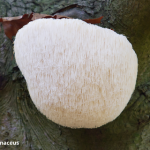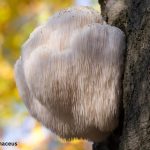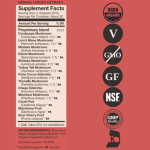When it comes to supporting brain health, picking our favorite mushroom is, well, a no-brainer.* The Lion’s Mane mushroom is always our top pick. (Learn more about the best mushrooms for brain health.*) We love that not only can you look for Lion’s Mane fruiting bodies in the woods in many parts of the country, but more farmers are growing it — so you can often enjoy it as a tasty meal. But when it comes to supplements, we’ve noticed a trend we wanted to discuss: lion’s mane mycelium does not have the same quality or potency as lion’s mane fruiting bodies.
We never use mycelium in our products — from Reishi for relaxation to Cordyceps Militaris for energyyou always get certified organic fruiting bodies.
What is lion’s mane mycelium?
Let’s start by saying: For the mushroom, the mycelium is quite valuable. This part forms a dense network underground, like tree roots, and lays the groundwork so that a mushroom can grow in a particular environment.
Lion’s mane mycelium is usually invisible to our eyes – it works its mushroom magic underground or on a log or in a tree. But while lion’s mane mycelium is essential for the mushroom’s survival, it has not traditionally been used to support your health.* When you delve into the annals of herbal history, you find that the fruiting bodies have always been used for thousands of years.
This article from Scientific American explains how cool the mycelium is. But this “scaffold” mushroom is not what you want in your supplements.
Because you want fruiting bodies – not lion’s mane mycelium
Fruiting bodies are the above-ground parts of a mushroom. These are the parts you may recognize as a “mushroom”. Lion’s mane fruiting bodies are the fluffy white part you see growing from a tree.
In the US, it is both cheaper, easier and faster to grow mycelium on fill substrates such as cereals than to grow fruiting bodies. That’s why so many products and supplements use Lion’s Mane mycelium. But cheaper, faster, and easier (especially with lots of fillers) isn’t what you want when it comes to your well-being.
Think of it this way: Why eat lettuce roots instead of waiting for a whole head of greens to grow? And with lion’s mane mycelium growing in grains, it is impossible to separate the mycelium from the grain, so you have a diluted mushroom product. (Similar to tempeh – once the soybeans are inoculated, you can’t separate the beans from the crops.). There is a way that companies can grow pure mycelium without the grains in something called a bioreactor, but again it’s much cheaper for them to grow it on cheap grains like rice or oats as a filler and mix it all together .
In the photo of this post, you’ll see the large white fruiting body — with the mycelium behind it. Which do you think is more powerful?
As mentioned above, the mycelium or roots typically have up to 70-90% grain filler and lack many of the main functional compounds. To put on our science hat, lion’s mane mycelium lacks erikenones, dilinoyl-phosphatidylethanolamine (DLPE), amylovane, amikenon, 3-Hydroxyerikenone F, Hericenes, Hericerins and erinacerins which are well studied compounds to support nerve growth factor and all around cognitive health. True fruiting bodies also have up to 29 times more 1,3 1,6 β-glucans, which have been well studied to support immune health. This is why we We only use 100% fruiting bodies in our products at AdaptogenShrooms, so you don’t have to worry about the product going bad, being full of fluff or fillers, or being super watered.
Quick Review: Lion’s Mane Benefits*
Take a look at this mushroom and you might know why it’s used: It looks like a brain (sort of), and that’s its primary use, traditionally and according to modern research.*
Lion’s Mane fruiting bodies also:
- Supports mental clarity, focus and memory*
- smallsupports optimal nervous and immune system health*
- smallsupports brain and nervous system support*
- Supports cognitive function*
What you need to know before you buy
In addition to making sure you’re getting a tincture made with Lion’s Mane fruiting bodies—not Lion’s Mane mycelium—you should ask these questions:
1. Is your Lion’s Mane certified organic?
Mushrooms may be certified organic, but not all are. Ours happen to be USDA certified organic and it’s something we’re very passionate about – high quality products.
To maintain this certification, everything we use must also be organic, from our substrates (the material the mushrooms are grown on) to our cleaners. Every product we sell and every ingredient we use is assigned a batch number and can be traced.
2. How do you detangle your lion’s mane?
Mushrooms contain a wide variety of active ingredients and must be extracted for your body to access them. We always double export our lion’s mane. The active compounds in mushrooms are both alcohol-soluble (triterpenes) and water-soluble (beta-glucans). To get full-spectrum support from mushrooms, we extract ours with organic cane alcohol and hot water, then carefully combine the two.
We follow science and extract our lion’s mane (and all the mushrooms we use) at optimal alcohol percentages, temperatures and durations.
3. Has this lion’s mane been tested?
Before you buy, check to make sure your lion’s mane has been tested to be clean and strong.
Every batch of Lion’s Mane we use goes through lab testing. We test for heavy metals and biological contamination to ensure the purity of our products. We also check the concentration of the active compounds.
Want to try a Lion’s Mane supplement made with 100% fruiting bodies (and never Lion’s Mane mycelium)? Try any of our certified organic products Lion’s Mane products for cognition and memory.
ABOUT THE AUTHOR
Mushy is your mentor in the enchanting world of adaptogenic mushrooms. An expert in mycology and holistic medicine, he fuses contemporary science with traditional wisdom to lift the veil on the benefits of mushrooms for health and well-being. With an informed, science-based approach, Mushy guides you through the mysterious world of mushrooms that strengthen the balance and resilience of body and mind. Whether you’re a curious neophyte or a seasoned explorer of medicinal mushrooms, Mushy is your ally in the quest for a more harmonious and energetic life.







